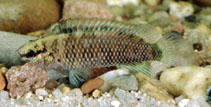http://www.fishbase.org/Summary/speciesSummary.php?genusname=Badis&speciesname=badis ---> http://192.134.151.83/Summary/speciesSummary.php?genusname=Badis&speciesname=badis
http://192.134.151.83/Summary/speciesSummary.php?genusname=Badis&speciesname=badis ---> https://fishbase.mnhn.fr/Summary/speciesSummary.php?genusname=Badis&speciesname=badis
https://fishbase.mnhn.fr/Summary/speciesSummary.php?genusname=Badis&speciesname=badis ---> https://fishbase.mnhn.fr/summary/Badis-badis.html
Badis badis, Badis : aquarium

You can
sponsor
this page
Common name (e.g. trout)
Genus + Species (e.g. Gadus morhua)
-

-
About this page
-
Languages
-
User feedbacks
-
Citation
-
Uploads
-
Related species
-


 Badis
Upload your
photos
and
videos
Badis
Upload your
photos
and
videos
Pictures
|
Videos |
Google image
 Badis badis
Badis badis
Picture by
Hippocampus-Bildarchiv
Teleostei (teleosts) >
Anabantiformes
(Gouramies, snakeheads) >
Badidae
(Chameleonfishes)
Etymology:
Badis:
'badis' is presumably a Bengali local name, possibly derived from 'bhedo' or 'bheda', but it lacks a proper reference. Probably incorrect etymology (J. Müller, pers. comm., April 2021, after information from native speakers)
.
More on author:
Hamilton
.
Environment: milieu / climate zone / depth range / distribution range
Ecology
Freshwater; benthopelagic; pH range: 6.0 - 8.0; dH range: 5 - 19. Tropical; 14°C - 30°C (Ref.
89918
)
Asia: Ganges River drainage in India, Bangladesh, and Nepal, from Himachal Pradesh (Yamuna River) to the estuary; the Mahanadi River drainage; Assam lowlands close to Brahmaputra (Kaziranga, Gauhati, and Dibru River) (Ref.
46238
). Also reported from Bhutan (Ref.
9418
) and Pakistan (Ref.
52665
).
Length at first maturity / Size / Weight / Age
Maturity: L
m
4.5
range ? - ? cm
Max length : 7.1 cm TL male/unsexed; (Ref.
102851
); max. published weight: 2.58 g (Ref.
111603
)
Dorsal
spines
(total): 15 - 17;
Dorsal
soft rays
(total): 7-10;
Anal
soft rays
: 6 - 8;
Vertebrae
: 26 - 28. The species has conspicuous dark blotch covering superficial part of cleithrum above pectoral fin base. Lacks a dark caudal peduncle blotch. Body depth 30.7-38.9%SL; interorbital width 6,5-8,3% SL; scales in lateral row 25-27; circumpeduncular scales 19-20; pectoral rays usually 12. Has a series of prominent dark blotches along dorsal fin base and/or a series of dark blotches along middle of dorsal fin; and has indistinct bars on side. Has a distal extrascapular (Ref.
46238
).
Occurs solitarily in rivers, ponds and ditches. Also found in swamps (Ref.
1479
). Feeds on worms, crustaceans and insects (Ref.
7020
). Used for behavioral studies (Ref.
4537
). Length indications of up to 8 cm in some publications are exaggerated (Ref.
89918
).
Life cycle and mating behavior
Maturity
|
Reproduction
|
Spawning
|
Eggs
|
Fecundity
|
Larvae
Produces 30-100 eggs. Distinct pairing with embrace (Ref.
31218
).
Kullander, S.O. and R. Britz
, 2002. Revision of the family Badidae (Teleostei: Perciformes), with description of a new genus and ten new species. Ichthyol. Explor. Freshwat. 13(4):295-372. (Ref.
46238
)
IUCN Red List Status (Ref.
130435
)
Least Concern (LC)
; Date assessed:
26 March 2010
CITES
Not Evaluated
Not Evaluated
Threat to humans
Harmless
Human uses
Fisheries: of no interest; aquarium: commercial
FAO - Publication:
search
|
FishSource
|
More information
Countries
FAO areas
Ecosystems
Occurrences
Introductions
Stocks
Ecology
Diet
Food items
Food consumption
Ration
Common names
Synonyms
Metabolism
Predators
Ecotoxicology
Reproduction
Maturity
Spawning
Spawning aggregation
Fecundity
Eggs
Egg development
Age/Size
Growth
Length-weight
Length-length
Length-frequencies
Morphometrics
Morphology
Larvae
Larval dynamics
Recruitment
Abundance
BRUVS
References
Aquaculture
Aquaculture profile
Strains
Genetics
Electrophoreses
Heritability
Diseases
Processing
Nutrients
Mass conversion
Collaborators
Pictures
Stamps, Coins Misc.
Sounds
Ciguatera
Speed
Swim. type
Gill area
Otoliths
Brains
Vision
Tools
Bio-Quiz
|
E-book
|
Field guide
|
Identification keys
|
Length-frequency wizard
|
Life-history tool
|
Point map
|
Classification Tree
|
Catch-MSY
|
Special reports
Check for Aquarium maintenance
|
Check for Species Fact Sheets
|
Check for Aquaculture Fact Sheets
Download XML
Summary page
|
Point data
|
Common names
|
Photos
Internet sources
AFORO (otoliths) |
Aquatic Commons
|
BHL
|
Cloffa
|
BOLDSystems
|
Websites from users
|
Check FishWatcher
|
CISTI
|
Catalog of Fishes
:
genus
,
species
|
DiscoverLife
|
ECOTOX
| FAO - Publication:
search
|
Faunafri
|
Fishipedia
|
Fishtrace
| GenBank:
genome
,
nucleotide
|
GloBI
|
Google Books
|
Google Scholar
|
Google
| IGFA World Record |
MitoFish
|
Otolith Atlas of Taiwan Fishes
|
Public aquariums
|
PubMed
| Reef Life Survey | Socotra Atlas |
Tree of Life
| Wikipedia:
Go
,
Search
| World Records Freshwater Fishing |
Zoological Record
Estimates based on models
Phylogenetic diversity index (Ref.
82804
): PD
50
= 0.5000 [Uniqueness, from 0.5 = low to 2.0 = high].
Bayesian length-weight: a=0.00617 (0.00338 - 0.01124), b=3.04 (2.88 - 3.20), in cm total length, based on LWR estimates for this species & (Sub)family-body (Ref.
93245
).
Trophic level (Ref.
69278
): 3.3 ±0.39 se; based on food items.
Resilience (Ref.
120179
): Low, minimum population doubling time 4.5 - 14 years (Fec=10-100).
Fishing Vulnerability (Ref.
59153
): Low vulnerability (10 of 100).
Back to Search
Random Species
Back to Top
Accessed through:
Not available
FishBase mirror site :
localhost
Page last modified by :
mrius-barile
- 20 July 2016
Fatal error
: Uncaught ArgumentCountError: Too few arguments to function checkEcotox(), 1 passed in /var/www/html/summary/speciessummary.php on line 2304 and exactly 3 expected in /var/www/html/includes/speciessummary.lib.php:2579 Stack trace: #0 /var/www/html/summary/speciessummary.php(2304): checkEcotox() #1 {main} thrown in
/var/www/html/includes/speciessummary.lib.php
on line
2579
|